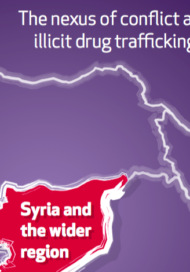Posted on 06 Aug 2013
The grinding maelstrom that is Syria’s civil war continues to churn. While the grievances behind the conflict are complex and variable, there is one enabling factor that has been vital – access to weaponry. Despite pleas from insurgent groups for more arms, the geographic reach of the conflict and its intensity are indicative of a situation awash in guns. This is a striking shift for a country that historically has had far fewer weapons in civilian hands than its neighbors. Where then does the plethora of weapons in insurgent hands come from, and how have they arrived there?
The most important early source of weaponry for the insurgents were government stockpiles. Government weapons and ammunition have fallen into rebel hands in three ways: purchased from corrupt government officials, via direct assault, in some cases immediately using captured weapons to sustain rolling offensives or brought by defecting soldiers. Since the beginning of the conflict Syria’s military has struggled to staunch a steady stream defectors from joining the insurgents. The presence of these former soldiers bring has both increased the lethality of the insurgency, and helped to shape the types of weapons in demand.
Since the beginning of the conflict the Syrian insurgency has also been supplied weapons smuggled in from neighboring countries. Initially, weapons trafficking groups operated on a small-scale, almost ad-hoc basis and were basically apolitical. Individuals and local smuggling networks procured weapons in Lebanon, Iraq, and Turkey, from commercial and civilian sources. Highlighting the irony of weapons being smuggled back into Syria which, in in previous years its government had smuggled to insurgent groups in neighboring states, a western diplomat noted, “it’s a case of the biter getting bitten.”
The start of the conflict caused a spike in regional weapons prices, with prices for Ak-47s, sniper rifles and handguns in Iraq increasing nearly four-fold. While expensive, regional sources were able to provide a host of weapons, including AK-47s, M-16s, shotguns, sniper rifles, rocket propelled grenade launchers, anti-tank missiles, and Katyusha rockets. Once procured, the weapons were moved across the often unguarded border between Syria and its neighbors by vehicle, donkey, or by foot, before being offered for sale inside the country. As the conflict ground on, and the potential for profits increased, ad-hoc smuggling efforts were taken over by established arms trafficking and professional criminal groups.
A more centrally organized effort to source weapons began in 2012. Representatives of the Free Syrian Army made contact with weapons dealers in Eastern Europe and the Black Sea region, hoping to procure weapons that would then be smuggled across the Turkish-Syrian border. The Syrian rebels also reached out to militia groups in Libya for assistance. The Libyan groups have proven to be a particularly important source of weapons for the Syrian insurgents. Brokers in Libya procure weapons that have either been donated by sympathetic groups, or purchased from the well-stocked black market. Once sufficient quantities have been stockpiles the weapons are shipped by sea or air to Syria’s neighbors. After the Lebanese government seized 60,000 rounds of ammunition being shipped through the northern port of Tripoli, the Libyan groups have mainly transported their weaponry via Turkey, and in a small number of cases Jordan. While the exact amount of weaponry smuggled via this channel is unclear, some smugglers have claimed that over 28 metric tons have been delivered via air alone.
Efforts by Libyan brokers to supply the rebels have coincided with, and perhaps been tied to, efforts by Turkey, Qatar, Saudi Arabia, and Jordan to arm the rebels. Active support for the insurgency emerged in early 2012, spearheaded by Qatar and Saudi Arabia. At present, the weapons are primarily sourced from Eastern Europe, Croatia, Libya, and Sudan, with the Qataris and the Saudis purchasing and transporting the weapons to Turkey and Jordan. A rough division labor has emerged, with Qatar primarily supplying groups in the north of the country, while Saudi Arabia provisions those groups in the south. The official pipeline both a magnitude of order larger than unofficial efforts – delivering an estimated 3,500 tons of weaponry – it is also providing increasingly sophisticated weaponry. In at least two recent cases, Qatar is believed to have provided rebels with portable anti-aircraft systems. While the United States is not believed to have provided large amounts of weaponry, it has played a role in developing the arms pipeline and in vetting the Syrian groups that receive the weapons.
The weapons channels supplying Syria’s insurgents comprise a complex, overlapping web of state, non-state and criminal actors. As the war grinds on these smuggling webs will become increasingly entrenched, and highly vulnerable to exploitation by organized crime groups. One needs look no further than the Balkans – where officially sanctioned smuggling routes were appropriated by crime groups as soon as the conflicts ended – for a vision of the organized crime challenge the Middle East may face in the coming decade.



